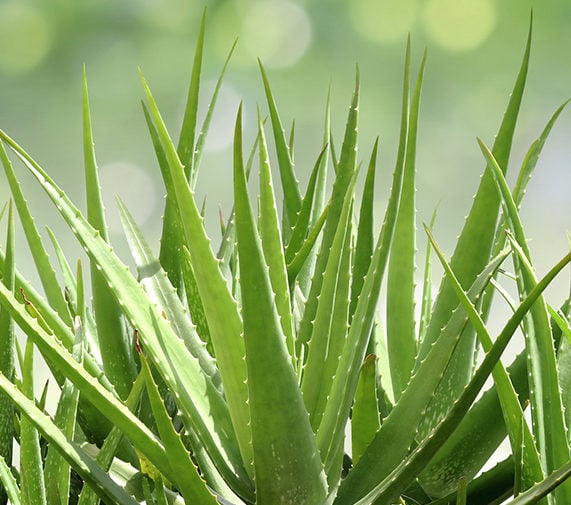This luscious plant delivers a big beauty boost.
Ancient Egyptians celebrated this fat, spiky succulent for its multitude of healing properties. Since then aloe vera has become a global, go-to cure-all, getting a cultivation boost in the 1930s. Today most aloe vera is grown in Mexico, followed by production in India, China, the West Indies and Middle America.
Aloe vera is packed with nutrients and can be administered topically or internally. It contains vitamins A, C, E B12, folic acid and choline, which act as antioxidants; eight enzymes that help dissipate sugars and fats; minerals such as calcium, chromium, copper, magnesium, manganese, potassium, sodium and zinc; fatty acids; and hormones and amino acids. We typically see aloe as an additive in skin products—but you may also want to think about adding a drop to a drink. One study of women over 45, who received daily doses of aloe vera (1,200-3,600 mg) as a dietary supplement taken orally, showed significant improvement in facial wrinkles and elasticity, believed to be from increased collagen or from an increase in blood supply to the tissue. But beware of ingesting too much. This could result in negative interactions with some medications, diarrhea and over-stimulated digestion, and blood-thinning.
Aloe vera, how else do we love thee? Let us count the ways:
As a burn remedy: Though it’s been known to help heal burns and radiation for centuries, researchers have tried to find out exactly how aloe vera gel, found inside the leaf, works. They haven’t completely nailed it, but they do understand that the protein metallothionein serves as an antioxidant and helps reduce the sensitivity from a burn.
For an anti-inflammatory agent: A study in London showed the antioxidants in aloe vera helped those who had inflammatory bowel disease. It’s also been suggested that it helps hemorrhoids, but doctors say to make sure you’re using the pure gel, not a cream mixed with other ingredients.
For a smooth move: The compounds found in the yellow latex part of the plant have laxative qualities and increase the water and mucous content of your digestive tract.
For the immunity boost: Studies with mice have demonstrated that aloe vera helps to reduce cancerous tumors, in addition to protecting the body from free-radical damage.
As an antiviral: Aloe vera has been shown to combat viruses such as herpes, varicella zoster and influenza (the virus we have to thank for the flu).
To help the scalp: Though there’s no positive link to aloe vera and hair growth, there is evidence that it helps to soothe seborrheic dermatitis on the scalp, which manifests as dandruff and scaly patches.
Grow Your Own
Even if your thumb is nowhere near green, the good news is that aloe vera is an easy plant to grow and maintain. The Old Farmer’s Almanac suggests making sure the pot has adequate drainage to avoid rot, lots of indoor light or sunlight and is kept in temperatures between 55° and 80° Fahrenheit.
Organic Beauty has a great primer for preparing the leaves (or you can buy it at a health-food store) and making a cleanser from the gel, vitamin E and essential oils. You Beauty has a list of 16 ways to use aloe on your face, including as a makeup remover, acne treatment, exfoliating scrub and moisturizer.
twistup
Love OrangeTwist?
Join our twistup membership and receive a $100 gift card today!




